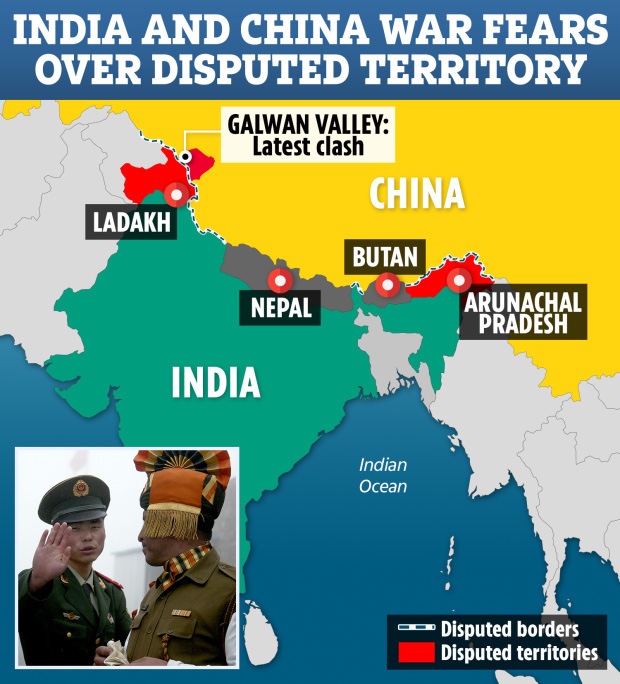Beijing made the threats in its state controlled media, claiming New Delhi would be “more humiliated than 1962”, referring to a short but vicious battle that saw more than 2000 killed.
India has scrambled fighter and spy planes for combat patrols and dispatched military reinforcements after a bloody clash erupted in the Galwan Valley, part of the disputed Ladakh region along the Himalayan frontier last week.
The fierce battle saw 500 soldiers engulfed in hand-to-hand combat — some using spiked clubs — in a gruesome clash that left at least 20 Indian and 40 Chinese soldiers dead.
But the Chinese Communist regime warned India that any future conflict would spell defeat for them like the 1962 war.
An article in the state mouthpiece, the Global Times, read: “Chinese military observers said that an escalated, large-scale military conflict involving main Chinese troops, if that were to happen, would mean a rout just like the war in 1962, with very disproportionate casualty figures unfavourable to India.
“In a potential self-defence counter-attack, China will secure its own territory and not likely claim Indian territory after emerging victorious, but the battle will deeply hurt India so much that global position and economy would go backwards to decades ago.”
India blames China for instigating the fight by developing military infrastructure in the valley, which it said was a breach of the agreement of what area remained in dispute.
In a development that has escalated the war threat, satellite images appear to show China carrying out a blatant land grab by diverting the Galwan river to claim more territory in the hotly contested region.
Pictures indicate that China is claiming the Galwan river’s sides up to 25 miles from The Line of Actual Control (LAC) – which separates Indian-controlled territory from Chinese-controlled territory.
Chinese engineers are reportedly altering the river’s course and reducing its width to allow soldiers to be deployed on the larger land mass.
This would significantly beef up its ability to project military power in the area and is a tactic that echoes Beijing’s construction of island staging posts in the disputed South China Sea which it claims its own
Yet, while China harks back to the 1962 Indian “rout”, experts fear the conflict could develop into something akin to World War Three.
Professor Joseph M. Siracusa, from the School of Global, Urban and Social Studies, told news.com.au: “In 1962, all these people were going at each other, but they didn‘t have nuclear weapons.
“Today, all the players in South Asia have nuclear weapons.
“In exchange of 10 or 15 missiles there are warheads, which would induce the ‘nuclear winter’ that Carl Sagan predicted in the 1980s. There could be all kinds of hell to pay for that.”
“Will they use nuclear weapons for a border dispute? Not because they want to, but because it might escalate or accidentally move into that area.”
China has laid claim to the entire Galwan Valley, saying the whole area is located on their side of the LAC.
Foreign ministry spokesman Zhao Lijian said: “Right and wrong is very clear and the responsibility entirely lies with the Indian side.”
Meanwhile India has dismissed China’s claim over the valley as “exaggerated” and “untenable”.
Previous agreements between the two sides mean no guns are taken close to the border by each side which suggests why spiked clubs were used in last week’s battle.

An Indian airforce warplane soars overheadCredit: Getty Images – Getty


No comments:
Post a Comment